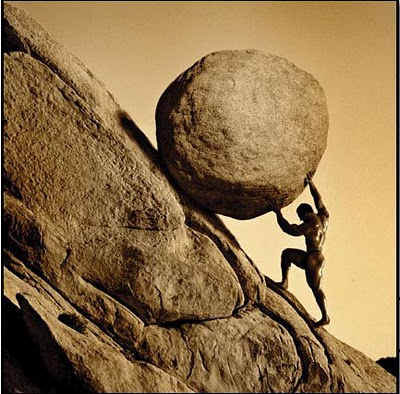Maintaining long-term motivation

The Sisyphean Challenge of Team Leadership
Maybe you remember Sisyphus from mythology – the guy who had to push the boulder uphill, only to have it tumble down as he neared the top. Sometimes leading a team feels like that: we feel we’re getting somewhere, but then we hit a roadblock, if not a boulder hurtling toward us. Maintaining long-term motivation is a big challenge. It’s easy to get a group started on a complex challenge (although it often doesn’t feel like it at the time), but keeping at it can be even more daunting.
Photo credit: Gerard Van der Leun via Flickr (Creative Commons license)
Understanding Motivation in Leadership
Our February Third Thursday, with Doug Dunston of St. Thomas University, tackled this topic. Doug began with what might be surprising: re-framing what we sometimes call “extrinsic motivation” by introducing the term amotivation. It’s what we’re experiencing when we say to ourselves “I have no idea why I’m doing this.” This shift in perspective recognizes that extrinsic motivation often isn’t really motivation at all, at least beyond a certain level of compliance. Compliance works for some tasks – but it has no ability to get a team very far on a big challenge. Sometimes we call this phenomenon being “volun-told” (which has become a meme – exercise caution when Googling).
The Pitfalls of Traditional Motivational Tactics
Is there an alternative? Doug had more bad news for us. Some of the tools we’re used to – deadlines, surveillance, evaluations, even some kinds of goals – have been found to be counter-productive (here’s an article; hunt on Google Scholar for the full version). They’re not just neutral, they actually undermine people’s intrinsic motivation to work on the challenge.
“It seems all the things that we have a tendency to try and do to get the team moving along might be destroying the efficacy of our team. So what do we do about this?”
Doug Dunston
A New Perspective on Motivation
The key to maintaining long-term motivation? Tapping into people’s basic human needs for autonomy, competence, and relatedness. Autonomy, even in small things, is a powerful tool. It’s why we ask every team member to volunteer to do a small task in a Strategic Doing workshop. On a team level, that builds trust: everyone is in this together. On the individual level, it satisfies people’s intrinsic need for autonomy. Paying attention to what’s going on at both the individual and the team levels is critical to helping a team tackle challenges. It requires leadership when the team launches its work together, as well as over the long haul, when the boulders start rolling downhill and the team’s resilience is tested.
Practical Insights from Doug Dunston
Doug had plenty of other helpful guidance – watch the February 2024 video for the full presentation (we’ll also send you the materials he shared).

Liz shepherds the expansion of the Lab’s programming and partnerships with other universities interested in deploying agile strategy tools. A co-author of Strategic Doing: 10 Skills for Agile Leadership, she also focuses on the development and growth of innovation and STEM education ecosystems, new tool development, and teaching Strategic Doing.
